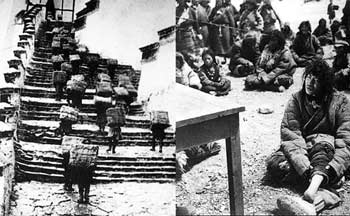China
Expert: Past serfdom in Tibet even crueler than that during Europe´s Middle Ages
WATCH VIDEO
Source: CCTV.com | 04-15-2008 09:17
Special Report: 3.14 Tibet RiotsSpecial Report: The Past of Tibet
Experts on Tibetan studies have revealed the cruel nature of the serfdom in Tibet, saying it was even worse than during the Middle Ages in Europe.
 |
| Left: Serfs carry goods to the Potala Palace. Right: A herdsman''s left foot was chopped by the head of his tribe. (File Photo) |
Research Fellow at China's Tibetology Research Center, Zhang Yun, recalls the history in Tibet. He said before the democratic reform in 1959, Tibet had long been under a serf system ruled by high-level monks and royal ranks, and was a integration of religion and politics. He calls it darker and crueler than serfdom during Europe's Middle Ages. At that time, 90 percent of people in Tibet were serfs. They owned no land, had no freedom, and their fates were tied to the manors to which they belonged. Their owners squeezed them with heavy work and usurious loans.
Their owners controlled them as private property, and even putting them up for sale, exchanges and mortgages.
The system in old Tibet did not provide democracy, freedom and human rights for the public, only giving privilege to the serf owners.
Tanzen Lhundrup, a researcher at the China Tibetology Research Center, or CTRC, says serf owners in Tibet are composed of local officials, aristocrats and high-level monks. Although this class represents less than five percent of the regions' population, they possess all the land used for farming and resources and a majority of livestock.
Professor Meng Guanglin, a researcher at the School of History in Renmin University of China, says serfs are like the agricultural laborers in the former feudal society of western Europe. Based on the feudal land system of ownership, serf owners occupy production materials, including land. The professor says those serf owners control all the serfs with the help of various powers including politics, law and customs. He says the essence is the same between the serf system in western Europe and the feudal serf system in Tibet, which combined political and religious powers. This includes the deprivation of production materials and achievements from the laborers, and the inhumane treatment of the serfs.
Zhang Yun said, "Before 1959, Tibet was ruled by the serf system. It was darker and crueler than the serf system during the Middle Ages in Europe. 90 percent of people in Tibet were serfs, owning no lands, having no freedom, and having their fate tied to the manors to which they belonged."



